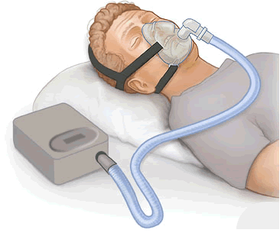No two patients have exactly the same needs and circumstances when it comes to their oral and overall health concerns, and the same is true for those afflicted with sleep apnea. That’s why oral appliance therapy or CPAP therapy alone isn’t enough to treat every single patient as a “one size fits all” solution. Here at Sleep Better Illinois, Dr. Tim Stirneman works hard to create the ideal treatment plan for every sleep apnea patient he sees, and his approach may include combined oral appliance and CPAP therapy. Our goal is to help patients enjoy a better quality of sleep, strong health, and an overall happier life here in Lake in the Hills!
CPAP Therapy
CPAP (also known as Continuous Positive Airway Pressure) therapy relies on the use of a mask that’s designed to cover the mouth and/or nose. This mask constantly forces air down the patient’s throat and into their lungs; this keeps the airway clear and the oxygen levels at an adequate level, allowing patients to sleep well throughout the night.
CPAP is a time-tested method with predictable and successful results. However, the bulkiness, discomfort, and loud noises involved with the treatment have resulted in a high level of intolerance among patients. While many are able to eventually adjust to the new sensations, others have chosen to go without treatment altogether, which is dangerous for their wellbeing.

Oral Appliance Therapy
Oral appliance therapy is recommended by both the American Academy of Sleep Medicine (AASM) and American Academy of Dental Sleep Medicine (AADSM) as the ideal treatment option for patients who are either chronic snorers who don’t have sleep apnea, patients who have experienced CPAP intolerance, or patients with mild to moderate obstructive sleep apnea (OSA).
This treatment option can help patients sleep peacefully through the night by shifting the jaw to a more forward position and placing comfortable pressure on the tongue and soft tissue in order to keep the airway clear. The appliance is customized, easy to remove and clean, and conveniently portable for easy travel. However, not every patient is able to achieve the relief they need with oral appliance therapy alone.
Combined Treatment
In fact, those high settings can lead to painful headaches, dry mouth, and higher risks of intolerance. Combined treatment helps patients stay more comfortable by reducing their CPAP treatment levels while maintaining a high level of effectiveness and compliance. Plus, with the use of the oral appliance during travel, patients never have to go without treatment.
Valuable Benefits
Improved Compliance.
Because comfort is improved and noise levels are decreased with combined therapy, more patients are likely to use their CPAP systems and oral appliances on a regular and effective basis.
Increased Comfort.
Combined therapy relies on a smaller, less intrusive nasal mask instead of the traditional overall facial mask. With the help of the oral appliance, patients are able to enjoy easier breathing with their CPAP system on a lower setting,
More Effectiveness.
When using combined therapy, patients experienced a noticeable reduction in the number of apnea (a pause in breathing for 10 or more seconds) and hyopnea (breathing that is excessively shallow and/or slow) instances they experienced each night. On the Apnea-Hypopnea Index (AHI), groups that were receiving no treatment experienced an average of 6.6 events each hour. Groups using CPAP systems experienced 4.4 events.
Added Convenience
Many people who solely rely on CPAP systems go without treatment while on trips. When using combined therapy, patients are able to easily bring along their customized oral appliance and better protect themselves from ill effects during these times.

Dr. Tim Stirneman
“Are you ready to learn more about solutions to sleep apnea? Have you attempted to use CPAP therapy and found that you’re intolerant? Are you unhappy with the results you’re achieving from oral appliance therapy?
No matter what category you fall into, don’t hesitate to meet with me for a complimentary consultation. I’ll review any past treatment you’ve experienced, the results from your most recent sleep test, and other important diagnostic information that will help us determine whether combined therapy could be the right choice for you.
You deserve a restful, healthy sleep. Let me help you get it!”